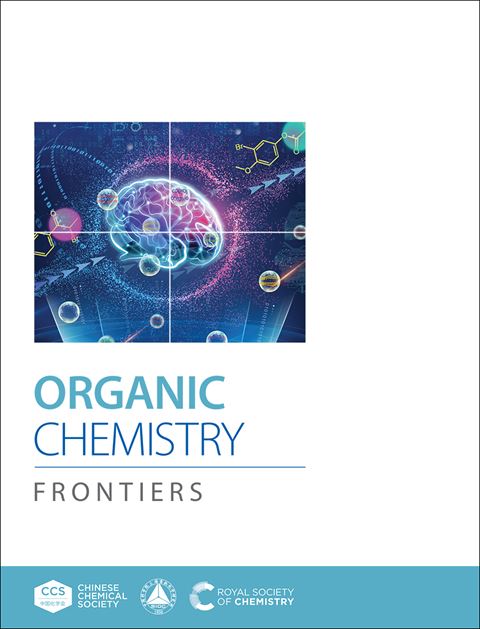在铱催化的烯丙醚和炔的立体选择性偶联中,配体控制的非对映选择性的机制见解:DFT观点
IF 4.6
1区 化学
Q1 CHEMISTRY, ORGANIC
引用次数: 0
摘要
调节反应的非对映选择性非常有吸引力,但极具挑战性,密度泛函理论计算用于研究铱催化配体控制的非对映选择性开关丙炔C−H功能化。从能量上来说,最优选的途径是通过(a) bf3辅助提取甲氧基,(b)质子从四甲基哌啶(TMPH)转移到二烯的不饱和键上,以及(c)丙炔和烯丙基之间形成c−c键,以提供合成的通用1,5-炔产物。发现原位生成的MeOBF3−在配体和进入的底物之间作为反离子保持关联,并在对映体控制(以及翻转决定步骤)亲核加成过程中控制非对映选择性中起关键作用。通过改变配体的手性可以获得具有两个连续立体中心的产物的所有两个立体异构体,发现手性诱导依赖于磷酰胺的手性部分与反离子MeOBF3−之间的协同作用。由于配体手性在催化微环境中的变化,使得手性腔与反离子在非对映选择性过渡态上发生了非共价相互作用,从而实现了高效、选择性的转化。因此,提出了一种逆配体协同诱导的立体控制方法,发现立体控制过渡态中相应的NCIs是使立体化学上不同的过渡态成为能量最低的过渡态的区分因素。本研究不仅对丙炔C−H非对映选择性官能化机理有了深入的了解,而且还建立了一种用于精确立体控制的新型反配体协同策略,为不对称催化合成复杂手性分子提供了一种通用而高效的方法。本文章由计算机程序翻译,如有差异,请以英文原文为准。
Mechanistic insights into ligand-controlled diastereoselectivity in iridium-catalyzed stereoselective coupling of allylic ethers and alkynes: a DFT perspective
Regulating the diastereoselectivity of a reaction is highly attractive but extremely challenging, density functional theory computations are employed to investigate an iridium-catalyzed ligand-controlled diastereoselectivity switch propargylic C−H functionalization. Energetically most preferred pathway is found to proceed through (a) BF3-assisted abstraction of methoxide, (b) proton transferred from the tetramethylpiperidine (TMPH) to the unsaturated bond of dienes, and (c) C−C bond formation between propargyl and allyl moiety to furnish the synthetically versatile 1,5-enyne products. The MeOBF3− generated in situ generation is found to remain associated between the ligand and incoming substrates as a counterion, and plays a key role in controlling the diastereoselectivity in the enantiocontrolled (as well as the turn-over determining step) nucleophilic addition. All two stereoisomers of the product bearing two contiguous stereogenic centers could be accessed by changing the chirality of ligands, the chiral induction was found to depend on the synergy that exists among chiral portion of the phosphoramidites and the counterion MeOBF3−. Due to the ligand chirality changes in the catalytic microenvironment, the noncovalent interactions (NCIs) is differentiated between the chiral cavity and the counterion in the diastereoselective transition states, therefore, the efficient and selective conversion is achieved. Therefore, a counterion-ligand cooperative induced stereocontrol approach is proposed, the corresponding NCIs in stereocontrolling transition states are found to be the differentiating factors rendering the stereochemically distinct transition states to be the lowest energy one. This study not only provides a deep mechanistic understanding of the diastereoselectivity propargylic C−H functionalization but also establishes a novel counterion-ligand cooperative strategy for precise stereocontrol, offering a versatile and efficient approach for the synthesis of complex chiral molecules in asymmetric catalysis.
求助全文
通过发布文献求助,成功后即可免费获取论文全文。
去求助
来源期刊

Organic Chemistry Frontiers
CHEMISTRY, ORGANIC-
CiteScore
7.90
自引率
11.10%
发文量
686
审稿时长
1 months
期刊介绍:
Organic Chemistry Frontiers is an esteemed journal that publishes high-quality research across the field of organic chemistry. It places a significant emphasis on studies that contribute substantially to the field by introducing new or significantly improved protocols and methodologies. The journal covers a wide array of topics which include, but are not limited to, organic synthesis, the development of synthetic methodologies, catalysis, natural products, functional organic materials, supramolecular and macromolecular chemistry, as well as physical and computational organic chemistry.
 求助内容:
求助内容: 应助结果提醒方式:
应助结果提醒方式:


